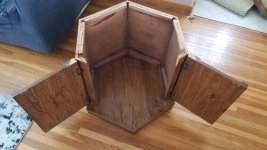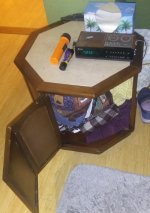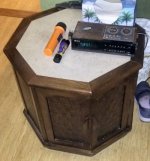I hope I am posting in the right category. I came across an end table for a living room and had thoughts of a bottom firing subwoofer enclosure. I have 3.24 cubic feet of gross volume. I would like to have the cabinet refinished and looking good... my concern would be making this into a proper enclosure. I am wondering if anyone has done anything like this and how it has turned out.
Also, I was thinking of ideas on how to seal the interior of this enclosure. Perhaps fiberglass along the interior to add strength and to seal this. There would be a new baffle built but other than that, the original wood would be used.
Thanks in advance for any suggestions.

Also, I was thinking of ideas on how to seal the interior of this enclosure. Perhaps fiberglass along the interior to add strength and to seal this. There would be a new baffle built but other than that, the original wood would be used.
Thanks in advance for any suggestions.
We have that table only with a marble insert in the top.
The shape is fine, the 3/4" flakeboard fixed panels are fine, but the loose doors!
Flip it over, cut an about-14" hole on the bottom. Like to front-mount a 15" driver; you have the cubes and need to get your hands inside. Cut a block of 2x6 beveled to fit behind the door crack. Get high-grade sticky caulk for glue and seal. Glue and screw the door block permanently, possibly from the front if you are not sure of doing it from inside without having screw-points coming through. When set, glue inside around all joints to seal and de-buzz, let set. Check speaker fit one more time. Half full of acoustic fluff should be plenty. Oh wait, forgot the wire!
Does the top come off? (I never looked.) From outside? That might simplify some steps.
The shape is fine, the 3/4" flakeboard fixed panels are fine, but the loose doors!
Flip it over, cut an about-14" hole on the bottom. Like to front-mount a 15" driver; you have the cubes and need to get your hands inside. Cut a block of 2x6 beveled to fit behind the door crack. Get high-grade sticky caulk for glue and seal. Glue and screw the door block permanently, possibly from the front if you are not sure of doing it from inside without having screw-points coming through. When set, glue inside around all joints to seal and de-buzz, let set. Check speaker fit one more time. Half full of acoustic fluff should be plenty. Oh wait, forgot the wire!
Does the top come off? (I never looked.) From outside? That might simplify some steps.
That should look nice refinished. The one thing that bugs me about down firing is GRAVITY which makes everything sag over time. And displaces the cone out of it's rest position. How much I should be able to calculate but it's too late here. Another obstacle is you'd have to put feet underneath to see up the whole end table, which might look peculiar. Maybe not too much height needed but to calculate that...bottom firing subwoofer enclosure
- What are the dimensions?
- Some pictures of the insides with the doors open would help, also of the doors (how thick?)
- Are you opposed to maybe just mounting a woofer(s) on the back? Consider it.
- Separate amp somewhere else? Or plate amp mounted to one facet?
- I cannot recommend Vance Dickason's Loudspeaker Cookbook (7th Edition) enough. There are a number of pages regarding enclosure stuffing.
- Internal bracing and anti vibration coating can do wonders, maybe something like https://cascadeaudio.com/car_noise_control/car_dampers.htm
Thanks for the response. The top does not come off. I have to come up with some thoughts on permanently affixing the door. Losing the hinges and sealing that up. Working from the bottom would be my thought. Also removing the lip around the bottom perimeter and adding some sort of feet that would fit the decor of the box.We have that table only with a marble insert in the top.
The shape is fine, the 3/4" flakeboard fixed panels are fine, but the loose doors!
Flip it over, cut an about-14" hole on the bottom. Like to front-mount a 15" driver; you have the cubes and need to get your hands inside. Cut a block of 2x6 beveled to fit behind the door crack. Get high-grade sticky caulk for glue and seal. Glue and screw the door block permanently, possibly from the front if you are not sure of doing it from inside without having screw-points coming through. When set, glue inside around all joints to seal and de-buzz, let set. Check speaker fit one more time. Half full of acoustic fluff should be plenty. Oh wait, forgot the wire!
Does the top come off? (I never looked.) From outside? That might simplify some steps.
AHA!! The Gravity factor. I did some research on the "sag factor"... cannot recall the exact phrase... but the formula is 24849/(Xmax*Fs2). Result should be under 5%. Shopping for the correct sub would be key. It's late here also... I'll post up dims when I get some daylight. I'll shoot some pictures also. The thickness (or lack thereof) of the entire cabinet is of concern to me, which is leading me to consider fiberglassing the interior. I'm not entirely opposed to mounting a driver to the back of the "enclosure". Would really like to make downfiring happen if possible though. Separate amplifier with the rest of the gear is what I'm considering. Loudspeaker cookbook is always nearby!!!! Great reference material. Thanks again for the response.That should look nice refinished. The one thing that bugs me about down firing is GRAVITY which makes everything sag over time. And displaces the cone out of it's rest position. How much I should be able to calculate but it's too late here. Another obstacle is you'd have to put feet underneath to see up the whole end table, which might look peculiar. Maybe not too much height needed but to calculate that...
- What are the dimensions?
- Some pictures of the insides with the doors open would help, also of the doors (how thick?)
- Are you opposed to maybe just mounting a woofer(s) on the back? Consider it.
- Separate amp somewhere else? Or plate amp mounted to one facet?
- I cannot recommend Vance Dickason's Loudspeaker Cookbook (7th Edition) enough. There are a number of pages regarding enclosure stuffing.
- Internal bracing and anti vibration coating can do wonders, maybe something like https://cascadeaudio.com/car_noise_control/car_dampers.htm
Bracing is about tying/interlocking all seven sides together to keep it from 'breathing' plus lightly preload the driver against the baffle and ideally mass loading the top with something removable and at least as heavy (preferably closer to 2x) as the assembled cab.
Here are additional images of the cabinet as it sits. As mentioned, sealing this up is key. Each side panel is about 10" in width if I'd do a side mount I'd be looking at 8" drivers. I think I'd like to stick with the downfiring aspect of this project.

Attachments
After looking at a picture I just posted.... The top is only screwed on!! Here's the cabinet with the top removed. I think this will be so much easier now to brace and get this all sealed up. Top and bottom of this cabinet are made of 3/4" MDF. I think I might router out another top/bottom section of MDF also.
Attachments
I think you had the solution with lining it with fibreglass. That will seal all the joins and strengthen. Make another 2 MDF panels to go behind the doors, and glue the doors to them.(before fibreglassing) As GM said, you could add bracing to tie all the walls together as well. (again, before fibreglassing)
Have a look at the Martin Logan Descent sub for an alternative to down firing, with opposing force cancellation as a bonus (2 opposing sides could house drivers with a cloth grill that matches the wood finish. The descent has 3 woofers but visually your cabinet reminded me of it)
Rob.
Have a look at the Martin Logan Descent sub for an alternative to down firing, with opposing force cancellation as a bonus (2 opposing sides could house drivers with a cloth grill that matches the wood finish. The descent has 3 woofers but visually your cabinet reminded me of it)
Rob.
Wow, Rob! Interesting! THIS is why I posted on here. Interesting idea!! Thank you! Hmmmmmm. 3 8's along the sides in the 3.24 cubic feet sealed? Or the single downfiring 15"?
Last edited by a moderator:
"The Gravity factor"-sounds like a science fiction novel! That formula can't be correct...well, come to think of it I guess it can. But I can only find it like two places and see no derivation of it. I should be able to derive it but just drove 2.5 hours in traffic from hell so while the curious part of the brain is willing the "do the work part" has checked out for now and reverted to status "brain dead" 😵 Hmmm, which 15" were you considering? Dayton Audio PA380-8 Cms=0.17mm/N. Mms=0.147kg. Fdown=0.174kg*9.8m/s^2≈1.7N. Displacement is then I think F*Cms? =1.7*0.17mm≈0.3mm so not much for that woofer. On day one...over time, I dunno. Literally. But down firing seems more elegant visually, unless you can incorporate grilles and have like triple 8" on every other face for force cancelling.The Gravity factor. I did some research on the "sag factor"... cannot recall the exact phrase... but the formula is 24849/(Xmax*Fs2). Result should be under 5%.
As for the height, Sd=845cm^2 = 131 in^2. At a diameter of let's say the 15" to get the same area you need circumference*height=131=15*pi*h --> you'd need to raise up the whole deal at least 3 inches. Is that enough really? Who knows, I'd put some kind of cone in the middle of the floor to help the air push to the side with less turbulence. I'd really want it raised up more, I don't know if 3" is enough to get a laminar flow. Even 3" might look a bit peculiar though.
HAHAH. Right!! But as I was researching down-firing, I found a couple places that were talking about it. What started it all, was I was thinking of building a Sonotube sub. But then I looked at this end table circa 1982 and I just knew there has got to be a way to make it work!!! As far as clearance.... 3" would be a minimum! The table has a skirt all the way around it that measures 2 3/4" to the bottom of the bottom shelf. So removing that skirt and designing some sort of aesthetically pleasing foot on the perimeter points wouldn't be too far of a stretch. This could either sound really good or really bad! HAHA. I'll have another glass of wine and think some more about it. I'd get out my examples of subs that may work for this.... but... wine. Clearer heads will prevail tomorrow."The Gravity factor"-sounds like a science fiction novel! That formula can't be correct...well, come to think of it I guess it can. But I can only find it like two places and see no derivation of it. I should be able to derive it but just drove 2.5 hours in traffic from hell so while the curious part of the brain is willing the "do the work part" has checked out for now and reverted to status "brain dead" 😵 Hmmm, which 15" were you considering? Dayton Audio PA380-8 Cms=0.17mm/N. Mms=0.147kg. Fdown=0.174kg*9.8m/s^2≈1.7N. Displacement is then I think F*Cms? =1.7*0.17mm≈0.3mm so not much for that woofer. On day one...over time, I dunno. Literally. But down firing seems more elegant visually, unless you can incorporate grilles and have like triple 8" on every other face for force cancelling.
As for the height, Sd=845cm^2 = 131 in^2. At a diameter of let's say the 15" to get the same area you need circumference*height=131=15*pi*h --> you'd need to raise up the whole deal at least 3 inches. Is that enough really? Who knows, I'd put some kind of cone in the middle of the floor to help the air push to the side with less turbulence. I'd really want it raised up more, I don't know if 3" is enough to get a laminar flow. Even 3" might look a bit peculiar though.
Sag is a direct function of resonance frequency. Same as car springs or phono needles.
Sadly Google is filling up with crap and I can't find the graph.
The acceleration of a hard-working speaker is much greater than gravity. Put it face up, sprinkle sand, play loud: they dance. Play loud and rip-out the guts, versus waiting for gravity to tear the speaker apart. While it would be "possible" to design a speaker to play badly face-up/down, that would be a poor design for other reasons. (What are we going to do when we move out in star-ships and don't have gravity to blame for our troubles?)
Sadly Google is filling up with crap and I can't find the graph.
The acceleration of a hard-working speaker is much greater than gravity. Put it face up, sprinkle sand, play loud: they dance. Play loud and rip-out the guts, versus waiting for gravity to tear the speaker apart. While it would be "possible" to design a speaker to play badly face-up/down, that would be a poor design for other reasons. (What are we going to do when we move out in star-ships and don't have gravity to blame for our troubles?)
Higher SPL due to lack of gravity? Or zero SPL due to the lack of atmosphere in space?Sag is a direct function of resonance frequency. Same as car springs or phono needles.
Sadly Google is filling up with crap and I can't find the graph.
The acceleration of a hard-working speaker is much greater than gravity. Put it face up, sprinkle sand, play loud: they dance. Play loud and rip-out the guts, versus waiting for gravity to tear the speaker apart. While it would be "possible" to design a speaker to play badly face-up/down, that would be a poor design for other reasons. (What are we going to do when we move out in star-ships and don't have gravity to blame for our troubles?)
No no no, don't let that happen!!! 🤣Clearer heads will prevail tomorrow.
Well it's really a function of gravity and the mass and the compliance, the resonance is a result of those. But probably you refer to that equation and yes the sag can calculate from resonance I must agree. As for sand, that's for weenies-FRUIT, that's the way to go, according to a best friend who had a giant woofer and a tube amp he borrowed from me. They used the sub as a fruit bowl and would crank it up to make the fruit dance. Until the tube amp started talking to them. Well, really, until the fire 😱😵Sag is a direct function of resonance frequency. The acceleration of a hard-working speaker is much greater than gravity. Put it face up, sprinkle sand, play loud: they dance.
- Home
- Design & Build
- Construction Tips
- Cabinet Help for Home Subwoofer




